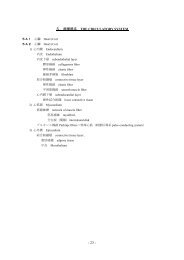Program / Abstract Book - KMU WWW3 Server for Education ...
Program / Abstract Book - KMU WWW3 Server for Education ...
Program / Abstract Book - KMU WWW3 Server for Education ...
You also want an ePaper? Increase the reach of your titles
YUMPU automatically turns print PDFs into web optimized ePapers that Google loves.
No. 68 (PP 1)<br />
The expressions of O 6 -methylguanine DNA methyltransferase and epidermal<br />
growth factor receptor on ganglioglioma: A clinicopathologic and<br />
immunohistochemical study<br />
I-Wei Chang 1,2 , Jui-Wei Lin 3<br />
1<br />
Department of Pathology, E-DA Hospital/I-Shou University<br />
2<br />
Institute of Biotechnology and Chemical Engineering, I-Shou University<br />
3<br />
Department of Pathology , Kaohsiung Chang Gung Memorial Hospital, Taiwan<br />
Background: Ganglioglioma (GG) is an uncommon brain parenchymal neoplasm. Although most cases<br />
have indolent clinical behavior, a subgroup of GGs with anaplastic change in the glial component has<br />
aggressive behavior and less favorable outcome. O6-methylguanine DNA methyltransferase (MGMT)<br />
is a DNA repair protein that removes mutagenic and cytotoxic adducts from O6-guanine in DNA. Lack<br />
of MGMT protein expression immunohistochemically is related to drug responses in patients of<br />
malignant glioma treated with alkylating agents. EGFR is the most frequently amplified gene in<br />
glioblastoma and associated with tumor invasiveness, angiogenesis, poor survival, and resistance to<br />
radiation therapy. To elucidate the relationship between the statuses of the MGMT as well as EGFR<br />
proteins and the tumor grading and prognosis, we conduct this study.<br />
Methods: Clinicopathologic and immunohistochemical study of nine cases was per<strong>for</strong>med.<br />
Results: This series included four men and five women with a mean age of 21.4 years at first surgery.<br />
Immunohistochemically, the MGMT and EGFR protein expressions tended to be more intensive in<br />
anaplastic GG, corresponding to the worse prognostic predictive value of 3+ MGMT and 2+ EGFR<br />
staining in glial cell component, as well as 1+ EGFR staining in neuronal cell components.<br />
Conclusions: The series showed that MGMT and EGFR protein expressions tended to be more<br />
intensive in anaplastic ganglioglioma.<br />
- 121 -



